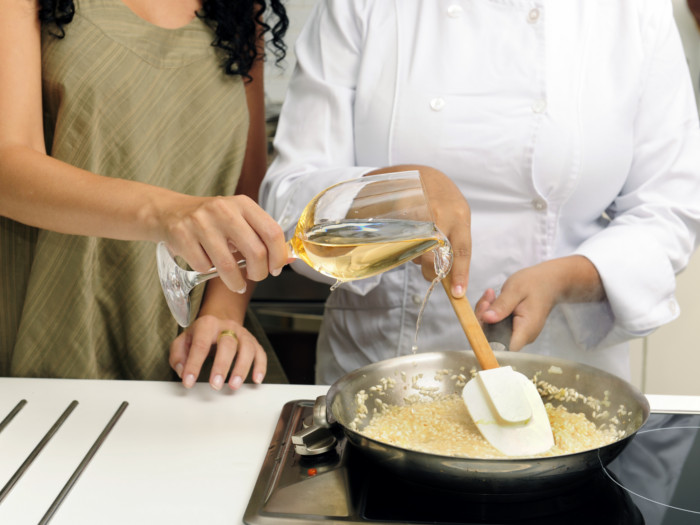Cooking wine is a versatile and widely available type of wine that may not be ideal for drinking, but can add great flavor to certain dishes!
What is Cooking Wine?
Cooking wine is a lower quality wine that is marketed specifically for use in cooking, rather than drinking. Regular wine is often prized for its nuance and boldness of flavor, but when cooking, the bold flavor will fight against the other flavors in the dish. Lower quality wine with fewer unique qualities will provide the wine flavor profile without overwhelming the dish. However, aside from quality, there is no difference between regular and cooking wine, and regular wine can be substituted in most recipes. [1]

Cooking wines have a subtler flavor profile. Photo Credit Shutterstock
| Serving Size : | |
|---|---|
| Nutrient | Value |
| Water [g] | 88.9 |
| Energy | 50 |
| Energy [kJ] | 209 |
| Protein [g] | 0.5 |
| Ash [g] | 1 |
| Carbohydrate, by difference [g] | 6.3 |
| Sugars, total including NLEA [g] | 1.55 |
| Calcium, Ca [mg] | 9 |
| Iron, Fe [mg] | 0.4 |
| Magnesium, Mg [mg] | 10 |
| Phosphorus, P [mg] | 15 |
| Potassium, K [mg] | 88 |
| Sodium, Na [mg] | 626 |
| Zinc, Zn [mg] | 0.08 |
| Copper, Cu [mg] | 0.01 |
| Selenium, Se [µg] | 0.2 |
| Riboflavin [mg] | 0.01 |
| Niacin [mg] | 0.1 |
| Vitamin B-6 [mg] | 0.02 |
| Folate, total [µg] | 1 |
| Folate, food [µg] | 1 |
| Folate, DFE [µg] | 1 |
| Choline, total [mg] | 5 |
| Alcohol, ethyl [g] | 3.3 |
| Sources include : USDA [2] | |
Types of Cooking Wine
There are several different types of cooking wine available such as Sauvignon Blanc, Pinot Grigio, and unoaked Chardonnay and they all serve distinct flavor purposes. The best way to decide on the kind of wine you need, if the recipe isn’t specific, is to look at the other flavors in the dish and find a complementary match. Many recipes will also offer substitutions for people who are looking to avoid alcohol.
- Dry reds and dry whites are best in any kind of wine-based sauce, where the flavor itself is the star, or in cream-based dishes, which require the acidity to shine through. [3]
- Dry, nutty, or oxidized wines work well with rich seafood, like shellfish or swordfish, artichokes, and any dish where the flavor of the wine needs to stand up well against fat.
- Sweet, nutty, or sweet oxidized wines are good for baking or nut-based desserts.
- Sweet fortified red wines like port are excellent in very rich, chocolate desserts.
- Sweet white wines are also used for desserts, but they work in sauces for dressing light meats, like flaky fish or certain preparations of poultry. [4]
- Rice wine is the go-to cooking wine for any Asian-inspired recipe or dish requiring a touch of umami.
Sherry Vinegar vs. Sherry Cooking Wine
Let us take a look at the differences.
- Sherry is a fortified white wine, originally from Spain, that was fortified with brandy. Sherry cooking wine often has salt added as a preservative, which makes it unsuitable for drinking. You can read What Is Sherry for more details. [5]
- Sherry vinegar is vinegar made from sherry wine and was thought to be discovered when barrels of sherry went bad during the wine’s aging process. Modern-day commercial sherry vinegar is often made directly from sherry grape varietals, not sherry wine.
- The two are not appropriate substitutes for each other, as one is sweet and the other is very acidic.
- If you need a substitute for sherry cooking wine, a very dry white or red will work best. Additionally, to substitute for sherry vinegar, try a red wine or apple cider vinegar.
Word of Caution: Cooking with alcoholic beverages results in only some loss of alcohol content. Foods baked or simmered in alcohol can retain anywhere from 4 percent to 85 percent of the alcohol, according to a study by the U.S. Department of Agriculture’s Nutrient Data lab. Also, if you are following a total avoidance of alcohol, you may want to skip using different kinds of wine vinegar as they do still contain some level of alcohol. [6]
